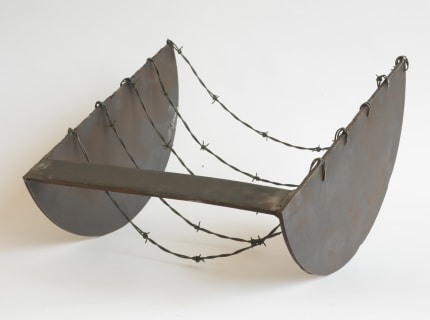AT the Neuberger Museum at the State University of New York here is an old-fashioned blockbuster exhibition containing a large number of imposing sculptures with historical depth. It is a retrospective of work from the last 30 years by Melvin Edwards. The sculptor, who welds his steel pieces out of a studio in Plainfield, N.J., is gaining a growing nationwide reputation as a mature talent with urgent things to say.
Mr. Edwards is a large, powerful-looking man whose works are clear records of that strength. The show contains a videotape of him in his alien-looking welder's gear, fusing various metal objects together; it is obvious how readily the forms flow out of the person. The pieces he works on in the video are from his much-discussed series titled "Lynch Fragments." There are 70 of these compressed works in the show, and the way they are arrayed one after the other on the gallery walls reminds one of a string of bullet holes made by an outsized antiaircraft gun.
"Lynch Fragments" is not a pretty title, and the works are meant to disturb; but they also fascinate and elicit an occasional laugh. They range from the essentially frontal and symmetrical "Afro Phoenix No. 2" (1964) to the exercise in loose and loopy forms that is "Dry Days" (1992). Variety results from the deft way that the artist shepherds his arsenal of materials, which includes heavy chains, blacksmith nails, scissors and even horseshoes, which portend either good luck or bad depending on the way they are turned.
Mr. Edwards traffics in unvarnished sexual imagery and understands how phallic forms can be both threatening and funny. But apart from the emotion residing in each of these fragments, there is an underlying and carefully considered planar structure that might have been inspired by African masks. A fortunate sidelight of the exhibition is that its display of 130 pieces is interrupted by works from the Neuberger's permanent collection of African sculpture. It is bracing to have evidence of the roots of Mr. Edwards's art.
Historically, the fragments remind us of the work of pioneering 20th- century sculptors like Picasso, Julio Gonzalez and David Smith. It is also fortunate that their work may currently be seen in a major exhibition "Picasso and the Age of Iron" at the Guggenheim Museum in Manhattan. But time spent among the fragments gives the impression that they aren't achieved as much by sweat work as by natural, albeit mystical, accretion. A frequent motif in the pieces is half of an oblong chain link, and his half resembles a magnet, which spurs the sensation that the objects constituting a piece might be magically drawn together.
The overly compacted nature of the fragments -- a lynching is often a choking -- is countered by an opposite sensibility in Mr. Edwards's larger work.
A roomful of larger, colorful sculptures reveals a more convivial and social side to Mr. Edwards. In many of these he is taking a page from the book of Anthony Caro, whose works are characterized by the welding together of metal fragments in a linear way so that the pieces roam through and mark a wide area of space.
One of the happiest of these pieces is the bright yellow "Dancing in Nigeria" (1974-78) composed of two wide and airy parts that seem to be bumptious partners. Some of the metal in the piece is the familiar industrial type that bears a raised lozenge pattern. In this context, the pattern could signify textile design or the texture of raffia, often worn by African dancers.
If this piece lends itself to literalness, other work is characterized by a balancing off of blithe elements with the dire ones that are never far from Mr. Edwards's reach. "Ntrytry" (1981) is composed of a superstructure of staid yellow triangles and is a fairly geometric assembly. But the elements are disconcertingly linked by a heavy chain hung slackly through them.
A glossary of the African words used for some of the titles is provided for viewers. Although ntrytry is listed as untranslatable, many other words when understood are poetic and set one dreaming. Few exhibitions take the trouble to provide such translations, and it is real service.
Other sculptures are tabletop-size unpainted steel pieces that combine elements of the fragments and the rangier painted works. In fact, one of the earliest lynch fragments from the early 1960's is not a wall piece but is done on a tabletop. One of these tabletop or pedestal pieces, "Artist's Voice" (1984), features a steel palette with a chain around it, which is easily interpreted as a remark on constraints or censorship.
With large monumental works Mr. Edwards runs up against the limitations faced by all sculptures meant to fit the immense scale of public spaces. They must, above all, be imposing. Mr. Edwards's frequent device is simply to add chain images to his looming elementary forms, and reverberations begin.
He has also come up with forms he calls "rockers," which rest on half circles. "Pamberi" (1988), which is the Zimbabwe version of the African-American proverb "Keep on keeping on" (or "keep on trucking") is a tabletop rocker. Outdoors in the Neuberger's courtyard, "Homage to Coco" (1970) is a boat-size one, whose arcs are linked by a row of chains, which rattle in the wind.
"Melvin Edwards Sculpture: A 30-year retrospective 1963-1993" is at the Neuberger Museum of Art on the SUNY Purchase campus through June 27. The number to call for more information is 251-6100.
...
Read review at nytimes.com.

